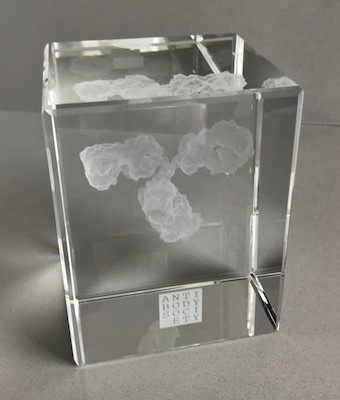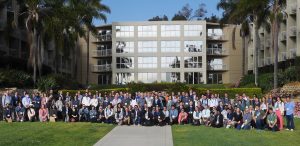We are excited to announce the new AIRR Community Executive Sub-committee recently elected at the AIRR Community Meeting. The AIRR-C Executive Sub-committee comprises a Chair (Victor Greiff), a Chair-Elect (Encarnita Mariotti-Ferrandiz), a Past Chair (Lindsay Cowell), and three elected Members of the AIRR Community (Christian Busse, Nina Luning Prak and Corey Watson). To learn more about the AIRR-C Exec SC members visit their webpages.
The Society thanks our retiring Directors
 The first annual meeting of The Antibody Society’s Board of Directors was held on December 2, 2007. Following their retirement on July 6, 2022, we are recognizing the outstanding contributions of four founding members: Dr. Andrew Bradbury, Prof. Dennis Burton, Prof. Andreas Plückthun and Prof. Jamie Scott. In addition, we are acknowledging the strong contributions of Dr. Greg Adams who became a Director in 2013 and also retired on July 6th. Dr. Bradbury served as our first, and Prof. Scott as our second President. As stated by Dr. Bradbury: “the Society aimed to provide a forum and voice for the thousands of people working in this area and to help attract and encourage young students to all facets of the field”. Amongst other things, this initially was done by ensuring the excellent scientific content of the Antibody Engineering & Therapeutics conference. Since that time, the Society has grown into a mature and world-renowned non-profit trade organization with ~ 2400 members from academia, government agencies and industry, and financially supported by over 40 companies ranging from the smallest biotech companies to the largest pharma firms.
The first annual meeting of The Antibody Society’s Board of Directors was held on December 2, 2007. Following their retirement on July 6, 2022, we are recognizing the outstanding contributions of four founding members: Dr. Andrew Bradbury, Prof. Dennis Burton, Prof. Andreas Plückthun and Prof. Jamie Scott. In addition, we are acknowledging the strong contributions of Dr. Greg Adams who became a Director in 2013 and also retired on July 6th. Dr. Bradbury served as our first, and Prof. Scott as our second President. As stated by Dr. Bradbury: “the Society aimed to provide a forum and voice for the thousands of people working in this area and to help attract and encourage young students to all facets of the field”. Amongst other things, this initially was done by ensuring the excellent scientific content of the Antibody Engineering & Therapeutics conference. Since that time, the Society has grown into a mature and world-renowned non-profit trade organization with ~ 2400 members from academia, government agencies and industry, and financially supported by over 40 companies ranging from the smallest biotech companies to the largest pharma firms.
The Society thanks Drs Bradbury and Adams and Profs Burton, Plückthun and Scott for their dedication and service, which has enabled the Society to grow and thrive. Each retiring member was given a special award for outstanding contributions to the Society, in the form of a piece of art which was specifically commissioned for them.
More information about The Antibody Society’s Board of Directors can be found here.
Announcing the inaugural AIRR Community Service Prize Winner!
We are thrilled to announce the inaugural AIRR Community Service Award winner, which recognizes individuals who have made significant contributions to the AIRR Community. The first recipient of this award was Dr. Christian Busse, a distinguished immunologist and pioneer in the field of AIRR research who was presented with the award at the AIRR Community Meeting VI in La Jolla, California in May 2022.
The AIRR Community Service Award was established to acknowledge individuals who have demonstrated a deep commitment to the AIRR Community, including contributions to the development of standards and tools for the analysis of immune receptor repertoires, advancing the field through research, and sharing knowledge with other members of the community.
Christian Busse, of DKFZ in Germany, has been an active member of the AIRR Community for many years, serving as a member of the Executive Sub-committee and Co-lead of the Standards Working Group. In these roles he contributes to the development of standards and best practices for AIRR analysis, helping to ensure that the Community continues to advance and grow.
We would like to extend our warmest congratulations to Christian Busse on this well-deserved award. His contributions to the AIRR Community have been truly outstanding, and we are honored to recognize him as the first recipient of the AIRR Community Service Award!
From Breakthrough to Blockbuster: The Business of Biotechnology
The biotechnology industry is highly complex and encompasses a wide range of enterprises, including monoclonal antibody therapeutics research and development. The new book ‘From Breakthrough to Blockbuster: The Business of Biotechnology’ (Oxford University Press, 2022) written by experts in the field, Donald L. Drakeman, Lisa N. Drakeman, and Nektarios Oraiopoulos, provides an insightful view into the inner workings of the industry and the characteristics of biotechnology firms vs those of traditional pharmaceutical companies. The authors provide thoughtful and thorough analysis of the biotech ecosystem, which includes academic researchers, investors and other funders, contract research and manufacturing organizations, and corporate partners.
The book begins with discussion of the scientific advances, particularly recombinant protein and monoclonal antibody technologies, on which the biotechnology industry was founded, as well as the overall process of drug development, which is lengthy and expensive. A key point is that most biotech firms do not have the internal expertise to perform all the required work, which includes manufacturing and clinical trials of the drugs they wish to market. Therefore, access to the biotech ecosystem, and the ability to pay for external services, is critical for success.
The authors then describe sources for the intellectual property on which biotech firms are founded and the various ways these organizations can raise funds, typically starting with venture capital, then potentially an initial public offering. Biotech firms also benefit from alliances with pharmaceutical companies, which can provide validation of their work as well as funding. While discussing aspects of the dealmaking required for partnering and alliances, the authors make a key point – neither the biotech firm nor the pharmaceutical company can predict the outcome due to the substantial number of variables and the complexity of the drug development process, and the historical high rate of failure.
In addition to ideas and funding, the biotech industry must have entrepreneurs who serve as founders and managers. The authors outline the general characteristics of biotech entrepreneurs, which include being adept at creative problem solving, having a high level of achievement motivation, being comfortable taking risks and doing new things, and having a high tolerance for rejection and failure. A substantial amount of the entrepreneur’s time will be spent on fund-raising, so they must create a compelling story about what the firm is doing, why this is important, and their plans for the future to pitch to venture capitalists. In making alliances, the entrepreneur must have a clear understanding of the forces driving decisions at the prospective partner company.
The penultimate chapter focuses on the question of who has developed the most innovative drugs – the biotech industry or traditional pharmaceutical companies. The authors make a strong case that the biotech industry is better at this process because its decision-making process is fundamentally different. The biotech industry is a decentralized system composed of thousands of firms that generate multiple projects and run parallel searches under highly competitive conditions. Investors looking for timely exits can place substantial pressure on company managers to perform “killer experiments” designed to disprove key hypotheses, and thereby quickly distinguish between projects that should proceed vs those that should be terminated. In contrast, traditional pharmaceutical firms tend to have centralized decision-making processes that lead to fewer projects and slower decisions to terminate projects.
In the final chapter, the authors discuss the future of the biopharmaceutical industry, which is critically dependent on government and insurers to pay for the drugs once they are approved for marketing. The biotech industry must offer value sufficient to attract investors, but the price of the resulting products cannot place an overwhelming burden on healthcare systems. Striking a balance between these opposing forces is critical to maintaining a robust biotech industry capable of producing new advances in medicine.
Throughout the book, the authors provide data that support their points in numerous figures and tables. Valuable references are provided in the copious footnotes, which also provide amusing asides (for example, a quote from The Pirates of Penzance, discussion of the origin of biotech company names, a reference to a possible link between juvenile delinquency and subsequent entrepreneurship). In recommending ‘From Breakthrough to Blockbuster: The Business of Biotechnology’, we can only agree with the authors’ summary:
“…this book will be a useful resource for management students and scholars, biomedical scientists, venture capitalists and other investors, entrepreneurs, healthcare policy makers, and all others interested in how new medicines come into being, why the process is so breathtakingly expensive, and how small entrepreneurial ventures can compete in one of the world’s most expensive and heavily regulated industries. Beyond that, the story of how a vast collection of inexperienced, underfunded, and unprofitable small companies have created more life-changing new medicines for less money than the largest global pharmaceutical firms is well worth reading.”
AIRR Community Meeting VI – That’s a Wrap!
The AIRR-C “raison d’etre” is the standardization of AIRR-seq data and its associated metadata, related software tools, pipelines and repositories, etc., as well as efforts aimed at other users, institutions, agencies, journals, and societies to promote international efforts to optimize FAIR practices: making data Findable, Accessible, Interoperable, and Reusable! Similarly, the spirit of accessibility of data, and training, equally applies to individuals from diverse backgrounds, including those from under-represented groups. Using these premises as inspiration the sixth AIRR-C meeting theme “Exploring New Frontiers” was established.
The sixth AIRR Community Meeting (#AIRRC6) was held in La Jolla, CA from May 17-19, 2022. The meeting had two themed “Challenge Sessions” meant to: (i) Initiate and implement a strategic plan for the AIRR Community that integrates the Working Groups’ activities toward the central goal of universally accepted AIRR-seq data standards; (ii) Introduce the Community to multidimensional systems approaches for characterizing immune responses, and how AIRR-seq data can benefit such approaches.
Meetings and presentations took place at the Hilton La Jolla Torrey Pines as well as virtually. The meeting provided opportunities for investigators and trainees to network, to participate in AIRR Community Working Groups and Sub-committee meetings, to participate in poster sessions, to attend software tool demonstrations and tutorials, to participate in student mentoring sessions and matchups and to attend an industry networking reception with a “hot topics in the field” round table session. We were delighted to have such an incredible turnout of industry collaborators and wish to extend our sincere thank you to our generous sponsors.
AIRR Community Meetings are the premier event for research on adaptive immune-receptor repertoires. They are also the primary location where the AIRR Community’s Working Groups and Sub-committees come together in one location to discuss how to push standardization in AIRR-sequencing (AIRR-seq) data and analysis forward. For complete details about AIRR-C Meeting VI check out the final meeting booklet and the video recordings on the AIRR-C YouTube channel.
Just like the biology of immune repertoires is high-dimensional, this meeting’s success was as well! We gathered some of the numbers that best describe the success of the AIRR-C VI meeting.
- 4 Keynote speakers: Dennis Burton (Scripps Research), Gunilla Karlsson Hedestam (Karolinska Institutet), Shane Crotty (La Jolla Institute for Immunology) Atul Butte (University of California, San Francisco)
- 144 in person attendees, 89 remote attendees, 20 countries represented
- 13 Invited speakers, 6 contributed talks
- 45 posters, 8 lightning demos, 6 deep dive tutorials
- 5 hot topics in the field discussions
- 19 sponsors – 5 gold, 5 silver, 7 bronze, 2 institutional
- 8 NIH travel award recipients
A big thank you again to our meeting sponsors for their generous sponsorship and engagement and to the AIRR-C Meetings Sub-committee members for their tireless effort in creating such an exceptional event.
Looking forward to AIRR-C Meeting VII – rumour has it that it will be in Europe in Spring 2024!




